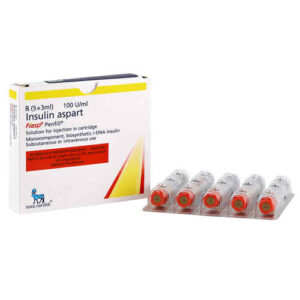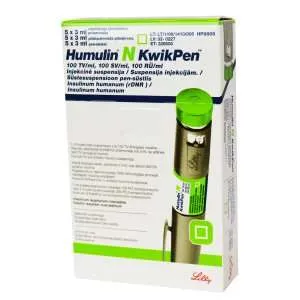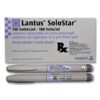No products in the cart.
Lantus Solostar Pens (100 UnitsmL)
$129.64 – $622.14
The Lantus SoloStar Pen is a premium, prefilled insulin delivery device that simplifies diabetes management for individuals with type 1 and type 2 diabetes. Each Lantus SoloStar Pen contains insulin glargine, a long-acting insulin that provides up to 24 hours of consistent blood sugar control. Designed for ease of use, this disposable pen allows patients to adjust their dosage from 1 to 80 units in precise 1-unit increments, ensuring accurate administration for effective diabetes care.
Lantus SoloStar Pen: Comprehensive Guide
Introduction
The Lantus SoloStar Pen is a significant advancement in the management of diabetes mellitus, a condition affecting millions of people worldwide. As a long-acting insulin formulation, Lantus SoloStar Pen offers patients a reliable means of controlling blood sugar levels throughout the day and night. This guide aims to provide in-depth information about the Lantus SoloStar Pen, its usage, administration techniques, side effects, and precautions necessary for effective diabetes management.
Overview of Diabetes Mellitus
Before delving into the specifics of Lantus SoloStar Pen, it is essential to understand diabetes mellitus, its types, and how insulin plays a vital role in treatment.
What is Diabetes Mellitus?
Diabetes mellitus is a chronic medical condition characterized by high blood sugar levels (hyperglycemia) resulting from either insufficient insulin production by the pancreas or the body’s inability to effectively utilize the insulin it produces. There are three main types of diabetes:
1. Type 1 Diabetes: An autoimmune condition where the immune system attacks insulin-producing beta cells in the pancreas, leading to little or no insulin production. Patients with type 1 diabetes require lifelong insulin therapy.
2. Type 2 Diabetes: This form is more prevalent and is often linked to lifestyle factors, including obesity, physical inactivity, and poor diet. In type 2 diabetes, the body either becomes resistant to insulin or does not produce enough to maintain normal glucose levels. It may initially be managed with lifestyle changes, oral medications, and insulin when necessary.
3. Gestational Diabetes: This type occurs during pregnancy and typically resolves after childbirth. However, it can increase the risk of developing type 2 diabetes later in life.
The Role of Insulin
Insulin is a hormone produced by the pancreas that regulates blood sugar levels by facilitating the uptake of glucose into cells for energy. In individuals with diabetes, insulin therapy becomes crucial for managing blood glucose levels and preventing complications associated with the disease.
What is the Lantus SoloStar Pen?
The Lantus SoloStar Pen is a prefilled, disposable insulin delivery device that contains insulin glargine, a long-acting insulin formulation. Unlike rapid-acting insulins, which take effect quickly after injection, Lantus SoloStar Pen provides a steady level of insulin over an extended period, making it an effective option for managing blood sugar levels throughout the day and night.
Key Features of Lantus SoloStar Pen
– Long-Acting Insulin: Lantus SoloStar Pen starts to work several hours after injection and maintains consistent blood sugar control for up to 24 hours.
– Dosage Flexibility: The SoloStar pen allows patients to adjust their dosage from **1 to 80 units** in **1-unit increments**, providing customizable treatment based on individual needs.
– User-Friendly Design: The pen features a simple dial mechanism and a clear dosage window, making it easy for patients to administer insulin accurately.
– Single-Patient Use: Each pen is intended for use by one person only, ensuring safety and preventing cross-contamination.
– Alternative Options: Lantus is also available in vials and cartridges, but patients must be cautious to avoid confusion with other similar insulin products, such as Apidra SoloStar Pens.
Benefits of Lantus SoloStar Pen
The Lantus SoloStar Pen offers numerous benefits for individuals managing diabetes:
1. Consistent Blood Sugar Control
One of the primary advantages of using Lantus is its ability to provide steady blood sugar control over a 24-hour period. This long-acting effect reduces the risk of fluctuations in blood glucose levels, which can help minimize the risk of both hyperglycemia and hypoglycemia.
2. Convenience and Portability
The SoloStar pen is compact and easy to carry, making it convenient for patients to manage their insulin therapy while on the go. Its disposable nature eliminates the need for syringes and vials, simplifying the administration process.
3. User-Friendly Design
The pen’s ergonomic design and straightforward dosage dial enhance usability, making it easier for patients to self-administer insulin. Clear labeling and visual cues ensure that patients can confidently use the pen without confusion.
4. Improved Adherence to Treatment
The ease of use and flexibility offered by the Lantus SoloStar Pen can improve adherence to prescribed insulin regimens, which is crucial for effective diabetes management. Patients are more likely to follow their treatment plans when they find the process convenient and manageable.
Understanding Insulin Therapy
The Importance of Insulin Therapy
Insulin therapy is a cornerstone of diabetes management for many individuals, particularly those with type 1 diabetes and some patients with type 2 diabetes. The goals of insulin therapy include:
– Maintaining Blood Sugar Levels: Insulin helps regulate blood sugar levels, reducing the risk of complications associated with uncontrolled diabetes, such as neuropathy, retinopathy, and cardiovascular disease.
– Preventing Complications: Effective insulin management can help prevent acute complications like diabetic ketoacidosis (DKA) and severe hypoglycemia, which can be life-threatening.
Types of Insulin
Insulin is categorized based on its action profile:
1. Rapid-Acting Insulin: This type starts working within minutes and is used to manage blood sugar spikes after meals. Examples include insulin lispro (Humalog) and insulin aspart (Novolog).
2. Short-Acting Insulin: Typically taken 30 minutes before meals, this insulin type helps control postprandial blood sugar levels.
3. Intermediate-Acting Insulin: This insulin type covers insulin needs for half the day or overnight, often used in combination with rapid-acting or short-acting insulins.
4. Long-Acting Insulin: Lantus is classified as long-acting insulin, providing stable blood sugar control over 24 hours. Other examples include insulin detemir (Levemir) and insulin degludec (Tresiba).
Combining Insulin Types
Many patients with diabetes benefit from a combination of insulin types to achieve optimal blood glucose control. For instance, a patient may use a rapid-acting insulin for meals alongside a long-acting insulin like Lantus for baseline coverage. Such a regimen must be individualized based on each patient’s lifestyle, dietary habits, and blood glucose monitoring results.
Warnings and Precautions
While the Lantus SoloStar Pen is effective for managing diabetes, certain precautions are crucial to ensure safe usage.
1. Proper Administration
– Training Required: Patients must receive training from healthcare professionals on the correct administration techniques. Misadministration can lead to inaccurate dosing and blood sugar fluctuations.
– Avoid Sharing: The SoloStar pen is intended for single-patient use only. Sharing pens, syringes, or needles can lead to disease transmission, including viral infections such as HIV or hepatitis.
2. Safety Measures
– Needle Attachment: Always attach a new needle before selecting the dose. Using a new needle for each injection helps prevent contamination and blockages.
– Performing Safety Tests: Prior to each injection, perform a safety test to ensure that insulin flows correctly and that no air bubbles are present in the pen. This step is crucial for accurate dosing.
3. Monitoring Blood Sugar Levels
– Regular Monitoring: Patients should regularly check their blood sugar levels, especially when starting or adjusting insulin therapy. This helps identify patterns and trends that can inform treatment decisions.
– Adjustments Under Supervision: Any modifications to insulin dosages should only be made under medical supervision to prevent the risk of hypoglycemia or hyperglycemia.
4. Injection Site Considerations
– Site Rotation: Always rotate injection sites to prevent complications such as lipodystrophy (abnormal fat distribution) and localized cutaneous amyloidosis. Rotating sites helps maintain consistent insulin absorption.
– Avoiding Compromised Areas: Do not inject into areas with scarring, inflammation, or other skin conditions, as this can affect insulin absorption and efficacy.
5. Contraindications and Drug Interactions
– Not for DKA Treatment: Lantus is not indicated for the treatment of diabetic ketoacidosis, a severe complication of diabetes that requires immediate medical attention.
– Mixing Insulins: Lantus should not be mixed or diluted with other insulins, as this can alter its effectiveness and action profile.
– Administration Routes: Lantus should not be administered through an insulin pump or intravenously, as this may result in severe hypoglycemia.
6. Storage and Maintenance
– Storage Guidelines: Store the Lantus SoloStar pen at room temperature (between 15°C to 30°C or 59°F to 86°F) and avoid exposure to extreme temperatures. Unused pens should be stored in the refrigerator until needed.
– Expiration Dates: Pay attention to expiration dates of the Lantus SoloStar Pen and dispose of any expired or damaged pens appropriately.
Step-by-Step Usage Guide
Effective use of the Lantus SoloStar pen is critical for achieving optimal diabetes management. Here’s a comprehensive step-by-step guide for administering insulin using the SoloStar pen.
Step 1: Check the Insulin
1. Verify the Medication:
– Ensure you are using the correct pen by checking the label on your insulin pen. The Lantus SoloStar pen is gray with a lilac injection button.
2. Inspect the Appearance:
– Remove the pen cap and observe the insulin. It should be clear and colorless. Do not use if the insulin appears cloudy, colored, or contains particles.
Step 2: Attach the Needle
1. Prepare the Needle:
– Take a new, sterile needle from the package and remove the outer cap.
2. Clean the Rubber Seal:
– Wipe the rubber seal of the insulin pen with an alcohol swab to prevent contamination.
3. Attach the Needle:
– Firmly screw the needle onto the pen, ensuring it is secure and straight to avoid damaging the needle.
Step 3: Perform Safety Test
1. Select Dose:
– Turn the dosage selector to 2 units This ensures the mechanism is working properly.
2. Remove the Outer Needle Cap:
– Carefully remove the outer needle cap while keeping the needle pointing upwards.
3. Dislodge Air Bubbles:
– Gently tap the insulin reservoir to dislodge any air bubbles. Air bubbles can affect dosage accuracy.
4. Check Insulin Flow:
– Press the injection button to release a drop of insulin. If you see a drop, the pen is ready for use. If not, repeat the process to ensure proper functionality.
Step 4: Select Dosage
1. Reset Dose:
– After the safety test, ensure the dose window reads “0.”
2. Set the Desired Dose:
– Turn the dosage selector to the required number of units. Be mindful of the total number of units remaining in the pen to avoid over-dosing.
Step 5: Inject the Dose
1. Choose Injection Site:
– Select an appropriate injection site, typically the abdomen or thigh. Clean the area with an alcohol swab and allow it to dry.
2. Insert the Needle:
– Hold the pen like a dart and insert the needle into the skin at a **90-degree angle** for subcutaneous injections.
3. Inject the Insulin:
– Press the injection button fully and hold it down for **10 seconds**. This allows the full dose to be delivered.
4. Withdraw the Needle:
– Carefully withdraw the needle from the skin, ensuring not to rub the site.
Step 6: Remove and Dispose of the Needle
1. Replace Outer Needle Cap:
– Place the outer needle cap back on carefully to avoid accidental needle stick injuries.
2. Remove the Needle:
– Unscrew the needle from the pen and dispose of it in a proper sharps container.
3. Store the Pen:
– Replace the cap on the pen and store it according to the recommended storage guidelines.
Side Effects of Lantus SoloStar Pen
While the Lantus SoloStar Pen is effective for managing diabetes, it is essential to understand the potential side effects associated with its use.
Common Side Effects
1. Hypoglycemia:
– The most common side effect of Lantus SoloStar Pen, hypoglycemia occurs when blood sugar levels drop too low. Symptoms include dizziness, shakiness, confusion, sweating, and irritability. Severe hypoglycemia can lead to unconsciousness or seizures.
2. Injection Site Reactions:
– Patients may experience redness, swelling, pain, or itching at the injection site. These reactions are generally mild and resolve on their own.
3. Weight Gain:
– Some individuals may experience weight gain when starting to use Lantus SoloStar Pen due to increased glucose uptake by cells and reduced glucose excretion by the kidneys.
4. Allergic Reactions:
– Although rare, some individuals may experience allergic reactions to insulin. Symptoms may include rash, itching, or swelling at the injection site. Severe reactions can occur and require immediate medical attention.
Serious Side Effects
1. Hypokalemia:
– Insulin therapy may cause low potassium levels, leading to muscle weakness, cramping, and abnormal heart rhythms. Patients should be monitored for signs of hypokalemia, especially if they are on certain medications, such as diuretics.
2. Fluid Retention:
– Fluid retention can lead to swelling, especially in the legs and ankles, and may worsen pre-existing heart failure. Patients on thiazolidinediones (TZDs) should be monitored closely for signs of fluid retention.
Managing Side Effects
– Hypoglycemia Management: If experiencing symptoms of hypoglycemia, patients should consume fast-acting carbohydrates, such as glucose tablets or sugary snacks. For severe hypoglycemia, individuals should carry a glucagon emergency kit and ensure that friends and family are familiar with its use.
– Monitoring Injection Sites: Patients should regularly inspect injection sites for signs of inflammation or infection and alternate sites to avoid complications. Report any persistent or severe reactions to a healthcare provider.
– Consultation with Healthcare Provider: Always communicate any side effects experienced while using Lantus with a healthcare professional for potential adjustments to the treatment plan.
Lifestyle Considerations in Diabetes Management
In addition to insulin therapy, several lifestyle factors play a crucial role in managing diabetes effectively.
1. Dietary Choices
– Balanced Diet: Consuming a well-balanced diet rich in fruits, vegetables, whole grains, lean proteins, and healthy fats can help maintain stable blood sugar levels.
– Carbohydrate Counting: Many patients benefit from understanding carbohydrate content in foods, allowing them to make informed choices about meal planning and insulin dosing.
– Meal Timing: Consistency in meal timing can help regulate blood sugar levels. Patients should aim to eat at regular intervals and avoid skipping meals.
2. Physical Activity
– Regular Exercise: Engaging in regular physical activity helps improve insulin sensitivity, aiding in better blood sugar control. Patients should aim for at least 150 minutes of moderate-intensity aerobic activity per week.
– Consulting Healthcare Professionals: Before starting an exercise program, patients should discuss their plans with healthcare providers to ensure safety and appropriate blood sugar management during physical activity.
3. Stress Management
– Impact of Stress on Blood Sugar: Stress can elevate blood sugar levels due to the release of stress hormones. Patients should incorporate stress management techniques, such as mindfulness, yoga, or meditation, into their daily routines.
– Adequate Sleep: Prioritizing good sleep hygiene can positively impact blood sugar control and overall health.
4. Regular Monitoring and Follow-Up
– Blood Sugar Monitoring: Regularly monitoring blood sugar levels is essential for understanding the effectiveness of insulin therapy and making necessary adjustments.
– Healthcare Appointments: Regular check-ups with healthcare providers help assess overall diabetes management and address any concerns or complications.
Conclusion
The Lantus SoloStar Pen is an invaluable tool for individuals managing diabetes. Its long-acting insulin formulation, combined with the pen’s user-friendly design, provides a reliable means of achieving stable blood sugar levels. By understanding the proper usage, potential side effects, and lifestyle factors that contribute to effective diabetes management, patients can enhance their quality of life and reduce the risk of complications associated with the disease.
For successful diabetes management, it is essential to maintain an open communication with healthcare providers, adhere to prescribed treatment plans, and engage in healthy lifestyle choices. With the right tools and knowledge, individuals with diabetes can lead fulfilling lives while effectively managing their condition.
Additional information
| Lantus Solostar Pen - 100u/mL | 5 pens, 10 pens, 15 pens, 20 pens, 25 pens |
|---|











Reviews
There are no reviews yet.